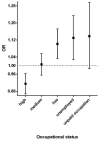Occupational status moderates the association between current perceived stress and high blood pressure: evidence from the IPC cohort study
- PMID: 23319539
- PMCID: PMC5899758
- DOI: 10.1161/HYPERTENSIONAHA.111.00302
Occupational status moderates the association between current perceived stress and high blood pressure: evidence from the IPC cohort study
Abstract
Although lay beliefs commonly relate high blood pressure (BP) to psychological stress exposure, research findings are conflicting. This study examined the association between current perceived stress and high BP, and explored the potential impact of occupational status on this association. Resting BP was measured in 122 816 adults (84 994 men), aged ≥30 years (mean age±standard deviation: 46.8±9.9 years), without history of cardiovascular and renal disease and not on either psychotropic or antihypertensive drugs. High BP was defined as systolic BP ≥140 mm Hg or diastolic BP ≥90 mm Hg. Perceived stress in the past month was measured with the 4-item perceived stress scale. A total of 33 154 participants (27.0%) had high BP (151±14/90±9 mm Hg). After adjustment for all variables except occupational status, perceived stress was associated with high BP (odds ratio [OR] for a 5-point increase: 1.06; 95% confidence interval [CI]: 1.03-1.09). This association was no longer significant after additional adjustment for occupational status (OR: 1.01; 95% CI: 0.99-1.04). There was a significant interaction (P<0.001) between perceived stress and occupational status in relation to BP: perceived stress was negatively associated with high BP among individuals of high occupational status (OR: 0.91; 95% CI: 0.87-0.96), but positively associated among those of low status (OR: 1.10; 95% CI: 1.03-1.17) or unemployed (OR: 1.13; 95% CI: 1.03-1.24). Sensitivity analyses yielded similar results. The association between current perceived stress and BP depends on occupational status. This interaction may account for previous conflicting results and warrants further studies to explore its underlying mechanisms.
Conflict of interest statement
Sébastien Czernichow has received consultancy fees from Novo and Sanofi and lectures fees from Servier. Tabassome Simon has received unrestricted research grants from Astra-Zeneca, Daiichi-Sankyo, Eli-Lilly, Glaxo-Smith-Kline, MSD, Novartis, Pfizer, Sanofi-aventis and Servier; speaker and consulting fees from AstraZeneca, Bayer-Schering, Eli-Lilly and Sanofi-aventis. Nicolas Danchin has received research grants from AstraZeneca, Daiichi-Sankyo, Eli-Lilly, Glaxo-Smith-Kline, MSD, Novartis, Pfizer, Sanofi-aventis, Servier and The Medicines Company; advisory panels or lecture fees from AstraZeneca, Bayer, Boehringer-Ingelheim, Bristol-Myers Squibb, Eli-Lilly, Menarini, Merck-Serono, Novo-Nordisk, Roche, Sanofi-Aventis and Servier. Emmanuel Wiernik, Bruno Pannier, Hermann Nabi, Olivier Hanon, Jean-Marc Simon, Frédérique Thomas, Kathy Bean, Silla M. Consoli and Cédric Lemogne have no conflict of interest to disclose.
Figures


References
-
- Chobanian AV, Bakris GL, Black HR, Cushman WC, Green LA, Izzo JL, Jr, Jones DW, Materson BJ, Oparil S, Wright JT, Jr, Roccella EJ. Seventh report of the Joint National Committee on Prevention, Detection, Evaluation, and Treatment of High Blood Pressure. Hypertension. 2003;42:1206–1252. - PubMed
-
- Chida Y, Hamer M. Chronic psychosocial factors and acute physiological responses to laboratory-induced stress in healthy populations: a quantitative review of 30 years of investigations. Psychol Bull. 2008;134:829–885. - PubMed
-
- Sparrenberger F, Cichelero FT, Ascoli AM, Fonseca FP, Weiss G, Berwanger O, Fuchs SC, Moreira LB, Fuchs FD. Does psychosocial stress cause hypertension? A systematic review of observational studies. J Hum Hypertens. 2009;23:12–19. - PubMed
-
- Levenstein S, Smith MW, Kaplan GA. Psychosocial predictors of hypertension in men and women. Arch Intern Med. 2001;161:1341–1346. - PubMed
MeSH terms
LinkOut - more resources
Full Text Sources
Other Literature Sources
Medical
Miscellaneous

